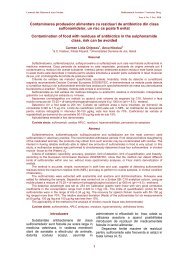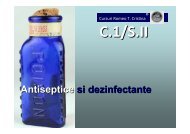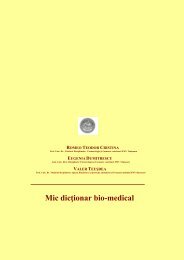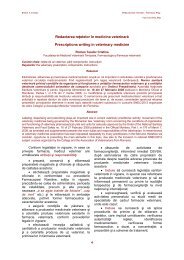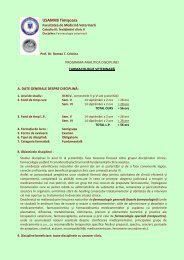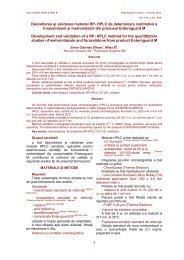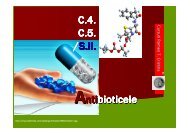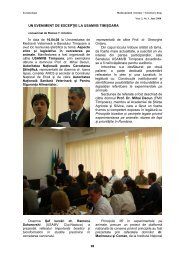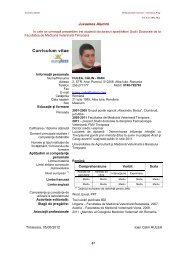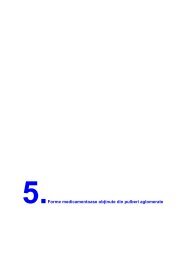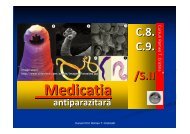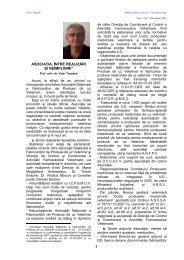Analiza reziduurilor de albendazol şi a metaboliţilor acestuia din ...
Analiza reziduurilor de albendazol şi a metaboliţilor acestuia din ...
Analiza reziduurilor de albendazol şi a metaboliţilor acestuia din ...
Create successful ePaper yourself
Turn your PDF publications into a flip-book with our unique Google optimized e-Paper software.
Ana Csuma & Ana Cișmileanu Medicamentul Veterinar / Veterinary Drug<br />
1<br />
Year 4, o. 2. ov. 2010<br />
<strong>Analiza</strong> <strong>reziduurilor</strong> <strong>de</strong> <strong>albendazol</strong> <strong>şi</strong> a metaboliților <strong>acestuia</strong> <strong>din</strong> țesuturi<br />
animale prin LC-MS/MS<br />
LC-MS/MS Analysis of <strong>albendazol</strong>e and its metabolites in animal tissues<br />
Ana Csuma, Ana Cişmileanu<br />
S.N. Institutul Pasteur S.A.<br />
Rezumat<br />
Tratarea animalelor cu produse medicamentoase <strong>de</strong> uz veterinar ridică problema <strong>reziduurilor</strong> care pot să<br />
persiste în unele țesuturi comestibile provenite <strong>de</strong> la animalele respective.<br />
Pentru stabilirea timpului <strong>de</strong> aşteptare necesar <strong>de</strong>pleției <strong>reziduurilor</strong> la concentrații suficient <strong>de</strong> scăzute<br />
pentru a nu afecta sănătatea omului, testele biologice efectuate pe animale implică utilizarea <strong>de</strong> meto<strong>de</strong> <strong>de</strong><br />
analiză suficient <strong>de</strong> sensibile <strong>şi</strong> <strong>de</strong> încre<strong>de</strong>re pentru <strong>de</strong>terminarea <strong>reziduurilor</strong>.<br />
Obiectivul acestei lucrări a fost stabilirea <strong>şi</strong> validarea unei meto<strong>de</strong> sensibile <strong>şi</strong> sigure pentru <strong>de</strong>terminarea<br />
simultană a <strong>albendazol</strong>ului <strong>şi</strong> metaboliților <strong>acestuia</strong>, <strong>albendazol</strong> sulfoxidul, <strong>albendazol</strong> sulfona <strong>şi</strong> amino<strong>albendazol</strong><br />
sulfona <strong>din</strong> țesuturi animale prin LC-MS/MS.<br />
Metoda implică hidroliza cu HCl 6N pentru eliberarea metaboliților legați <strong>de</strong> proteine, în particular a<br />
amino-<strong>albendazol</strong> sulfonei, în special <strong>din</strong> ficat, urmată <strong>de</strong> extracția cu acetat <strong>de</strong> etil <strong>şi</strong> purificarea extractului pe<br />
cartuş SPE C18. Separarea cromatografică s-a realizat pe o coloană XTerra MS C18 (10 cm x 2,1 mm x 3,5<br />
µm), folosind ca fază mobilă metanol-acid formic 0,1 % cu gradient <strong>de</strong> eluție.<br />
Detecția s-a făcut prin spectrometrie <strong>de</strong> masă în mod ESI + . S-au obținut limite <strong>de</strong> cuantificare mai mici <strong>de</strong><br />
4 µg/kg pentru fiecare component.<br />
Coeficienții <strong>de</strong> corelare (R 2 ) ai curbelor <strong>de</strong> calibrare (<strong>de</strong> la 0,01 µg/ml până la 0,5 µg/ml) au fost mai mari<br />
<strong>de</strong> 0,9935. Coeficienții <strong>de</strong> variație ai repetabilității pe țesuturi (muşchi <strong>şi</strong> ficat) contaminate natural provenite <strong>de</strong><br />
la animale tratate s-au situat între 5,75% <strong>şi</strong> 11,6%.<br />
Recuperările obținute pentru muşchi fortificat cu 10 µg/kg-100 µg/kg au fost între 70,2% <strong>şi</strong> 88% cu<br />
coeficienți <strong>de</strong> variabilitate între 5,4% <strong>şi</strong> 12,2%. Pentru ficat fortificat în domeniul 100 µg/kg-1000µg/kg s-au<br />
obținut recuperări între 70,3% <strong>şi</strong> 83,2% cu coeficienți <strong>de</strong> variabilitate între 5,7% <strong>şi</strong> 11%.<br />
Cuvinte cheie: <strong>albendazol</strong>, - sulfoxid, - sulfonă, 2- amino-<strong>albendazol</strong> sulfonă, LC-MS/MS, reziduuri.<br />
Abstract<br />
Treating the animals with veterinary medicines raise the issue of residues that can persist in their edible<br />
tissues. In or<strong>de</strong>r to establish the withdrawal time necessary for <strong>de</strong>pletion of the residues to sufficiently low<br />
concentration not to affect human health, biological tests performed on animals implicitly involve the use of<br />
sensitive and reliable analytical methods for residues <strong>de</strong>termination.<br />
The aim of this work was to establish and validate a sensitive and reliable method for simultaneous<br />
<strong>de</strong>termination of <strong>albendazol</strong>e and its metabolites, <strong>albendazol</strong>e sulfoxi<strong>de</strong>, <strong>albendazol</strong>e sulfone and 2-amino<strong>albendazol</strong>e<br />
sulfone in animal tissues by LC/MS/MS.<br />
The method involves acid hydrolysis with 6N HCl in or<strong>de</strong>r to release most residues, in particular the<br />
bound metabolite 2-amino-<strong>albendazol</strong>e sulfone especially from liver, followed by extraction with ethyl acetate<br />
and solid phase clean-up of the extract on a C18 SPE cartridge.<br />
The liquid chromatographic separation was achieved on a XTerra MS C18 column (10 cm x 2,1 mm, 3,5<br />
µm), with gradient elution of 0,1 % formic acid – methanol. Detection was performed by mass spectrometry in<br />
ESI + mo<strong>de</strong>. The limits of quantification were lower than 4 µg/ml for each component.<br />
The correlation coefficients (R 2 ) of the calibration curves (in the range from 0,01 µg/ml to 0,5 µg/ml) were<br />
higher then 0,9935. The relative standard <strong>de</strong>viations of repetability on samples naturaly contaminated from<br />
treated animals were between 5,75 % and 11,6 %.<br />
Recoveries from fortified muscles in the range of 10 µg/kg to 100 µg/kg were between 70,2% and 88%<br />
with relativ standard <strong>de</strong>viation of 5,4% - 12,2%. For liver fortified in the range of 100 µg/kg to 1000 µg/kg<br />
recoveries between 70,3% and 83,2% were obtained with relative standard <strong>de</strong>viation of 5,7 %-11 %.<br />
Key words: <strong>albendazol</strong>e, -sulfoxi<strong>de</strong>, -sulfone, 2-amino-<strong>albendazol</strong>e-sulfone, LC-MS/MS, residues.<br />
Introducere<br />
Helminții (cesto<strong>de</strong>, nemato<strong>de</strong>, tremato<strong>de</strong>)<br />
reprezintă grupa cea mai importantă <strong>de</strong><br />
paraziți care infestează rumegătoarele<br />
provocând pier<strong>de</strong>ri economice importante.<br />
Infestațiile la rumegătoare cu helminți<br />
sunt ținute sub control prin administrarea <strong>de</strong><br />
substanțe antiparazitare, care sunt esențiale<br />
pentru asigurarea stării <strong>de</strong> sănătate, a<br />
sporului <strong>de</strong> creştere în greutate <strong>şi</strong> a<br />
performanțelor <strong>de</strong> reproducție.<br />
Albendazolul<br />
Este un antiparazitar cu spectru larg <strong>din</strong><br />
clasa benzimidazolilor, fiind folosit ca<br />
antihelmintic în tratamentul infestațiilor
Ana Csuma & Ana Cișmileanu Medicamentul Veterinar / Veterinary Drug<br />
gastrointestinale <strong>şi</strong> pulmonare cu nemato<strong>de</strong><br />
(adulti, larve, ouă) (Cooperia spp.,<br />
Haemonchus spp., Ostertagia spp.,<br />
Oesophagostomum spp., Trichostrongyllus<br />
spp., Dictyocaullus spp., Bunostromum spp.),<br />
tremato<strong>de</strong> adulte (Fasciola spp., Dicrocelium<br />
spp., Paramphistomum spp.) <strong>şi</strong> unele cesto<strong>de</strong><br />
(Moniezia spp.).<br />
Administrarea <strong>albendazol</strong>ului se face pe<br />
cale orală prin boluri sau suspensie.<br />
Din tractul gastrointestinal al<br />
rumegătoarelor <strong>albendazol</strong>ul se absoarbe, în<br />
proporție <strong>de</strong> circa 50 %, fiind metabolizat<br />
rapid în ficat la metabolitul activ sulfoxid, apoi<br />
sulfonă inactivă <strong>şi</strong> ulterior prin <strong>de</strong>acetilarea<br />
grupării carbamat la aminosulfonă (6).<br />
Albendazolul, în principal sub formă <strong>de</strong><br />
metaboliți, se regăseşte în toate organele <strong>şi</strong><br />
țesuturile animalelor tratate.<br />
Cantitățile cele mai mari <strong>şi</strong> mai<br />
persistente <strong>de</strong> reziduuri se regăsesc în ficat<br />
urmat <strong>de</strong> rinichi, apoi în muşchi <strong>şi</strong> grăsime.<br />
Conform legislației în vigoare reziduul<br />
marker constă <strong>din</strong> suma <strong>din</strong>tre <strong>albendazol</strong> <strong>şi</strong><br />
metaboliții <strong>acestuia</strong> (8).<br />
Monitorizarea <strong>reziduurilor</strong> <strong>din</strong> produsele<br />
animaliere <strong>de</strong>stinate consumului uman<br />
necesită tehnici care să <strong>de</strong>termine atât<br />
compusul părinte cât <strong>şi</strong> metaboliții <strong>acestuia</strong> <strong>şi</strong><br />
să fie suficient <strong>de</strong> selective <strong>şi</strong> sensibile pentru<br />
<strong>de</strong>tectarea <strong>şi</strong> <strong>de</strong>terminarea acestora la nivelul<br />
limitelor maxime <strong>de</strong> reziduuri (LMR) stabilite<br />
<strong>de</strong> legislație (8).<br />
Există o serie <strong>de</strong> meto<strong>de</strong> <strong>de</strong> analiză<br />
publicate pentru <strong>de</strong>terminarea <strong>albendazol</strong>ului<br />
<strong>şi</strong> a metaboliților lui ca reziduuri în țesuturi <strong>de</strong><br />
origine animală.<br />
Meto<strong>de</strong>le <strong>de</strong> separare folosite au la bază<br />
cromatografia <strong>de</strong> lichi<strong>de</strong> <strong>de</strong> înaltă<br />
performanță iar ca tehnici <strong>de</strong> <strong>de</strong>tecție <strong>de</strong>tecția<br />
UV <strong>şi</strong> fluorescentă (3, 4) ca <strong>şi</strong> <strong>de</strong>tecția prin<br />
spectrometrie <strong>de</strong> masă [1, 2, 5).<br />
Utilizarea cromatografiei <strong>de</strong> lichi<strong>de</strong> in<br />
tan<strong>de</strong>m cu spectrometria <strong>de</strong> masă s-a dovedit<br />
o tehnică care satisface cerințele privind<br />
performanța meto<strong>de</strong>lor analitice ce pot fi<br />
folosite la <strong>de</strong>terminarea <strong>reziduurilor</strong> <strong>de</strong><br />
medicamente veterinare <strong>din</strong> produse<br />
animaliere <strong>de</strong>stinate consumului uman, adică<br />
specificitate, selectivitate, sensibilitate,<br />
fi<strong>de</strong>litate <strong>şi</strong> robustețe (7).<br />
Scopul lucrării<br />
A fost optimizarea <strong>şi</strong> validarea unei<br />
meto<strong>de</strong> eficiente, selective <strong>şi</strong> sensibile pentru<br />
<strong>de</strong>terminarea <strong>reziduurilor</strong> <strong>de</strong> <strong>albendazol</strong> <strong>şi</strong> a<br />
metaboliților <strong>acestuia</strong> <strong>din</strong> țesuturi.<br />
2<br />
MATERIAL I METODĂ<br />
Țesuturi animale<br />
Year 4, o. 2. ov. 2010<br />
S-au folosit țesuturi animale provenite <strong>de</strong><br />
la bovine tratate cu produsul Helmizol 1200<br />
(doza: 10mg <strong>albendazol</strong> / kg greutate<br />
corporală) în studiile <strong>de</strong> <strong>de</strong>pleție ale<br />
<strong>reziduurilor</strong> pentru stabilirea timpului <strong>de</strong><br />
aşteptare pentru acest produs.<br />
Standar<strong>de</strong> <strong>şi</strong> solvenți<br />
Pentru <strong>de</strong>terminări s-au folosit<br />
standar<strong>de</strong>le:<br />
• <strong>albendazol</strong>,<br />
• <strong>albendazol</strong> sulfoxid,<br />
• <strong>albendazol</strong> sulfonă <strong>şi</strong><br />
• 2-amino-<strong>albendazol</strong> sulfonă,<br />
procurate <strong>de</strong> la Witega GmbH, cu puritate<br />
certificată, acetat <strong>de</strong> etil, carbonat <strong>de</strong> potasiu,<br />
acid formic, acid clorhidric, bicarbonat <strong>de</strong><br />
potasiu, hexan, metanol HPLC <strong>de</strong> la Merck.<br />
S-au preparat soluții etalon stoc separate<br />
cu concentrația <strong>de</strong> 0,2 mg / ml în N,Ndimetilformamidă.<br />
Aceste soluții au fost apoi folosite pentru<br />
prepararea unei soluții etalon mixte conținând<br />
10 µg/ml <strong>din</strong> fiecare component, prin diluarea<br />
soluțiilor stoc cu metanol.<br />
S-au preparat 5 soluții <strong>de</strong> calibrare în<br />
domeniul (0,01 µg/ml - 0,50 µg/ml) prin<br />
diluarea soluției etalon mixte cu metanol.<br />
Extracție <strong>şi</strong> purificare<br />
La o cantitate cunoscută <strong>de</strong> țesut<br />
omogenizat (circa 2,5 g) s-a adăugat HCl 6N<br />
(5 ml) <strong>şi</strong> s-a supus hidrolizei (110 º C timp <strong>de</strong> 1<br />
h). Hidrolizatul s-a adus la pH 8 cu NaOH<br />
pelete <strong>şi</strong> după răcire la temperatura camerei<br />
s-a extras cu acetat <strong>de</strong> etil (5 ml).<br />
Extractul s-a evaporat la sec sub curent<br />
<strong>de</strong> azot (50 ºC) <strong>şi</strong> reziduul s-a reluat în<br />
amestec etanol:acid clorhidric 0,2 N (66:33)<br />
(1 ml) si n-hexan (5 ml), s-a agitat la agitator<br />
vortex (2 min) <strong>şi</strong> s-a centrifugat (1500 rpm, 5<br />
min, 4 ºC).<br />
Stratul superior <strong>de</strong> n-hexan s-a<br />
în<strong>de</strong>părtat. Extractul apos s-a modificat prin<br />
adăugare <strong>de</strong> soluție <strong>de</strong> bicarbonat <strong>de</strong> potasiu<br />
2 % (4 ml) si extractul <strong>de</strong> probă modificat (pH<br />
7-8) s-a purificat pe cartuş C18 (Waters),<br />
condiționat în prealabil cu acetat <strong>de</strong> etil (3 ml),<br />
etanol (3 ml) si apă distilată (3 ml).<br />
După transferul extractului <strong>de</strong> probă,<br />
cartuşul s-a spălat cu apă distilată (2 x 1 ml)<br />
<strong>şi</strong> s-a uscat prin trecerea aerului 5 min.
Ana Csuma & Ana Cișmileanu Medicamentul Veterinar / Veterinary Drug<br />
Albendazolul <strong>şi</strong> metaboliții <strong>acestuia</strong> s-au<br />
eluat cu acetat <strong>de</strong> etil (3 x 1 ml).<br />
Eluatul s-a concentrat sub curent <strong>de</strong> azot<br />
(50 º C) <strong>şi</strong> reziduul s-a reluat într-un volum<br />
cunoscut <strong>de</strong> metanol (1ml - 5ml), în funcție <strong>de</strong><br />
concentrația predictibilă.<br />
O cotă parte <strong>din</strong> extract (20 µl) s-a injectat<br />
în sistemul LC-MS/MS.<br />
<strong>Analiza</strong> LC<br />
<strong>Analiza</strong> s-a efectuat cu un cromatograf <strong>de</strong><br />
lichi<strong>de</strong> <strong>de</strong> înaltă performanță Waters 2695 in<br />
tan<strong>de</strong>m cu un <strong>de</strong>tector MS–MS Quatro micro<br />
(Micromass).<br />
Separarea cromatografică s-a făcut pe o<br />
coloană Xterra MS C18 (10 cm x 2,1 mm, 3,5<br />
µm), menținută la 30 0 C.<br />
Faza mobilă a constat <strong>din</strong>:<br />
- acid formic 0,1 % (solvent A)<br />
- metanol (solvent B) cu gradiente <strong>de</strong><br />
eluție: 0-2 min 10 % B, 2-3 min <strong>de</strong> la 10<br />
% B la 50 % B, 3-13 min 50 % B, 13-14<br />
3<br />
Year 4, o. 2. ov. 2010<br />
min <strong>de</strong> la 50 % B la 10 % B, 14-20 min<br />
10% B, cu un <strong>de</strong>bit <strong>de</strong> 0,2ml/min.<br />
Volumul <strong>de</strong> injecție: 20 µl.<br />
Parametrii MS / MS<br />
S-a aplicat MS în mod ESI pozitiv, cu<br />
următorii parametrii:<br />
- <strong>de</strong>bit gaz <strong>de</strong> <strong>de</strong>solvare (azot): 350 l/h;<br />
- temperatura <strong>de</strong> <strong>de</strong>solvare: 350 º C;<br />
- temperatura sursei <strong>de</strong> ionizare: 120 º C;<br />
- tensiunea la capilar 3,0 kV;<br />
- tensiunea la extractor 2V.<br />
Fragmentarea ionilor moleculari s-a făcut<br />
prin coliziune cu argon (3,0 x 10 -3 mbar).<br />
Timpii <strong>de</strong> retenție <strong>şi</strong> parametrii optimi<br />
pentru <strong>albendazol</strong> <strong>şi</strong> metaboliții <strong>acestuia</strong><br />
obținuți prin infuzie directă (<strong>de</strong>bit 10 µl/min)<br />
<strong>de</strong> soluții etalon (concentrație 1 µg/ml)<br />
folosind o pompă tip seringă <strong>de</strong> 100 µl<br />
(Hamilton) sunt prezentați în Tabelul 1.<br />
Ionii fragmentari <strong>şi</strong> parametrii MS / MS pentru ABZ <strong>şi</strong> metaboliții <strong>acestuia</strong><br />
Component tr (min)<br />
Ion precursor<br />
(m/z)<br />
Ioni<br />
fragmentari<br />
(m/z)<br />
Tensiunea<br />
la con<br />
(V)<br />
Energia <strong>de</strong><br />
coliziune,<br />
(eV)<br />
2-NH2-Abz 1,80 240,1 132,9 * ; 198,2 35 25<br />
Abz-sulfoxid 9,41 282 240,2 * ; 191,1 25 15<br />
Abz-sulfonă 9,99 298 266,2 * ; 223,1 35 20<br />
Abz 12,60 266 234,2 * ; 191,1 35 25<br />
* Ionul <strong>de</strong> cuantificare (cel mai abun<strong>de</strong>nt).<br />
Controlul MS s-a făcut cu sistemul <strong>de</strong><br />
date MassLynx, versiunea 4.1.<br />
Evaluarea ariilor, analiza <strong>de</strong> regresie a<br />
curbei etalon <strong>şi</strong> calculul concentrațiilor s-a<br />
făcut cu programul QuanLynx V4.1.<br />
REZULTATE I DISCUȚII<br />
Specificitatea a fost asigurată prin<br />
măsurarea a câte 2 ioni fragmentari rezultați<br />
<strong>din</strong> ionul precursor pentru fiecare substanță.<br />
S-au i<strong>de</strong>ntificat ca pozitive probele la care<br />
intensitățile relative ale ionilor fragmentari<br />
comparativ cu cei al soluțiilor etalon <strong>de</strong><br />
concentrații apropiate s-au încadrat în<br />
toleranțele maxime permise [3].<br />
Selectivitatea s-a stabilit prin analiza <strong>de</strong><br />
probe martor <strong>şi</strong> probe fortificate cu<br />
substanțele respective (figura 1 a, b <strong>şi</strong> c).<br />
Pe cromatograma martor nu se observă<br />
interferențe cu picuri semnificative la aceia<strong>şi</strong><br />
timpi <strong>de</strong> retenție cu ai <strong>albendazol</strong>ului <strong>şi</strong><br />
metaboliților <strong>acestuia</strong>.<br />
Tabelul 1<br />
S-a verificat linearitatea în domeniul 0,01<br />
µg/ml până la 0,5 µg/ml (figura 2).<br />
Coeficienții <strong>de</strong> corelare R 2 ai curbelor <strong>de</strong><br />
calibrare au fost pentru:<br />
- 2-amino-<strong>albendazol</strong> sulfonă 0,9935,<br />
- <strong>albendazol</strong> sulfoxid 0,9974,<br />
- <strong>albendazol</strong> sulfonă 0,9948 <strong>şi</strong><br />
- <strong>albendazol</strong> 0,9970.<br />
Limita <strong>de</strong> <strong>de</strong>tecție s-a calculat ca semnal /<br />
zgomot = 3 fiind estimată la 1,2 µg/kg <strong>şi</strong><br />
Limita <strong>de</strong> cuantificare ca semnal/ zgomot<br />
= 10 fiind estimată la 4 µg/kg pentru fiecare<br />
analit individual (figura 1b).<br />
La analiza a 6 probe paralele fortificate la<br />
limita <strong>de</strong> cuantificare, coeficientul <strong>de</strong> variație<br />
a fost mai mic <strong>de</strong> 20 %.<br />
Fi<strong>de</strong>litatea meto<strong>de</strong>i s-a verificat în termeni<br />
<strong>de</strong> repetabilitate pe probe contaminate<br />
natural provenite <strong>de</strong> la animale tratate<br />
(Tabelul 2) <strong>şi</strong> recuperări <strong>din</strong> probe martor<br />
fortificate (Tabelul 3).
Abz_115 MRM of 10 Channels ES+<br />
100<br />
0.19 0.38<br />
1.19 1.65<br />
1.26<br />
6.82<br />
5.78<br />
2.91<br />
5.40<br />
2.22 2.37 3.75 5.13 6.01<br />
4.10 4.33<br />
6.51<br />
3.29 3.49 4.44<br />
7.62<br />
9.77<br />
12.52<br />
12.64<br />
9.19 9.42<br />
10.30 11.41<br />
8.81<br />
12.06<br />
7.35<br />
8.08 11.03 11.64<br />
12.72<br />
8.27<br />
10.42<br />
14.13<br />
13.67<br />
298 > 266.2<br />
131<br />
14.78<br />
14.86<br />
0.88<br />
14.94<br />
%<br />
0<br />
1.00 2.00 3.00 4.00 5.00 6.00 7.00 8.00 9.00 10.00 11.00 12.00 13.00 14.00<br />
Abz_115 MRM of 10 Channels ES+<br />
100<br />
2.03<br />
0.38<br />
1.65 2.22<br />
0.92<br />
1.49<br />
3.87<br />
3.26 3.72<br />
2.76<br />
4.14<br />
6.01 6.36<br />
5.21 5.40 5.82<br />
5.06<br />
4.75<br />
8.16<br />
8.66<br />
7.32 7.58<br />
9.42 9.77<br />
7.20<br />
8.27<br />
9.00 9.23<br />
9.88<br />
7.77<br />
10.65<br />
12.18<br />
12.45<br />
11.45 12.64<br />
11.34<br />
282 > 240.1<br />
188<br />
13.48 14.48<br />
13.60<br />
14.25<br />
14.82<br />
0<br />
1.00 2.00 3.00 4.00 5.00 6.00 7.00 8.00 9.00 10.00 11.00 12.00 13.00 14.00<br />
Abz_115 MRM of 10 Channels ES+<br />
100<br />
5.78<br />
11.91<br />
12.79<br />
266 > 234.2<br />
191<br />
9.42<br />
10.11<br />
12.52 13.60 13.83<br />
0.46<br />
0.65 1.11<br />
1.23<br />
2.41<br />
2.03<br />
2.95<br />
3.94<br />
3.64<br />
5.09 5.48<br />
4.29 4.40<br />
6.43<br />
8.73<br />
6.97<br />
6.01 7.43 7.51 7.58 8.12 9.35<br />
8.35<br />
10.00<br />
10.30<br />
11.41<br />
11.26<br />
10.69<br />
13.02<br />
14.32 14.55<br />
%<br />
%<br />
0<br />
1.00 2.00 3.00 4.00 5.00 6.00 7.00 8.00 9.00 10.00 11.00 12.00 13.00 14.00<br />
Abz_115 MRM of 10 Channels ES+<br />
100<br />
9.19<br />
9.80<br />
9.04 9.69<br />
240 > 132.9<br />
581<br />
%<br />
0<br />
%<br />
%<br />
%<br />
%<br />
0<br />
1.03 1.26 1.65 2.37<br />
0.38<br />
2.95<br />
3.29<br />
3.79 4.02<br />
4.40 5.17 5.29 5.78 6.096.43<br />
7.47 7.81<br />
7.12<br />
4.75<br />
1.00 2.00 3.00 4.00 5.00 6.00 7.00 8.00 9.00 10.00 11.00 12.00 13.00 14.00<br />
a. proba martor <strong>de</strong> ficat<br />
8.77<br />
8.62<br />
9.88 10.76<br />
11.76<br />
11.9112.45<br />
11.41<br />
10.34<br />
14.86<br />
13.67 14.02 14.29<br />
Abz_036 MRM of 7 Channels ES+<br />
100<br />
S/N:PtP=42.93<br />
266 > 234.2<br />
4.92e3<br />
0<br />
1.00 2.00<br />
2.94<br />
3.00 4.00 5.00 6.00 7.00 8.00 9.00<br />
10.29<br />
10.00 11.00 12.00<br />
13.01 13.58 14.72<br />
14.50<br />
13.00 14.00 15.00<br />
Abz_036 MRM of 7 Channels ES+<br />
100<br />
S/N:PtP=34.18<br />
298 > 266.2<br />
2.43e3<br />
1.06 2.15 3.81 5.14 5.96 6.86 7.67 8.49<br />
11.67 12.27 12.76<br />
13.90<br />
14.15<br />
0<br />
1.00 2.00 3.00 4.00 5.00 6.00 7.00 8.00 9.00 10.00 11.00 12.00 13.00 14.00 15.00<br />
Abz_036 MRM of 7 Channels ES+<br />
100<br />
S/N:PtP=15.20<br />
282 > 240.2<br />
1.68e3<br />
0.63 1.25 1.80<br />
2.64 3.16<br />
2.83 3.84 4.24 4.93<br />
5.12 6.01<br />
5.63<br />
7.16<br />
8.11<br />
7.81 8.98 9.85 10.34 11.07 12.30 12.92<br />
0<br />
1.00 2.00 3.00 4.00 5.00 6.00 7.00 8.00 9.00 10.00 11.00 12.00 13.00 14.00 15.00<br />
100<br />
13.28 13.71<br />
14.58 14.86<br />
Abz_036 MRM of 7 Channels ES+<br />
S/N:PtP=9.89<br />
240.1 > 132.9<br />
929<br />
0.84 1.39<br />
0.73<br />
1.74<br />
2.45 2.97<br />
4.84 5.28 7.43<br />
3.92 5.09<br />
8.03 8.19<br />
4.16<br />
5.99 6.56 8.63 9.06<br />
9.50 10.31<br />
10.53 11.29 11.78<br />
10.99 12.44<br />
Time<br />
1.00 2.00 3.00 4.00 5.00 6.00 7.00 8.00 9.00 10.00 11.00 12.00 13.00 14.00 15.00<br />
b. probă <strong>de</strong> ficat fortificat cu <strong>albendazol</strong> <strong>şi</strong> metaboliții <strong>acestuia</strong> la nivel <strong>de</strong> 4 µg/kg fiecare.<br />
9.52<br />
13.17<br />
13.99<br />
14.26<br />
14.77<br />
Time
Ana Csuma & Ana Cișmileanu Medicamentul Veterinar / Veterinary Drug<br />
%<br />
%<br />
%<br />
%<br />
0<br />
5<br />
Year 4, o. 2. ov. 2010<br />
Abz_038 MRM of 7 Channels ES+<br />
100<br />
9.82<br />
298 > 266.2<br />
3.14e4<br />
0<br />
1.00 2.00 3.00 4.00 5.00 6.00 7.00 8.00 9.00 10.00 11.00 12.00 13.00 14.00 15.00<br />
Abz_038 MRM of 7 Channels ES+<br />
100<br />
9.28<br />
282 > 240.2<br />
1.57e4<br />
0<br />
1.00 2.00 3.00 4.00 5.00 6.00 7.00 8.00 9.00 10.00 11.00 12.00 13.00 14.00 15.00<br />
Abz_038 MRM of 7 Channels ES+<br />
100<br />
12.35<br />
266 > 234.2<br />
3.46e4<br />
0<br />
1.00 2.00 3.00 4.00 5.00 6.00 7.00 8.00 9.00 10.00 11.00 12.00 13.00 14.00 15.00<br />
Abz_038 MRM of 7 Channels ES+<br />
100<br />
1.50<br />
240.1 > 132.9<br />
2.85e4<br />
%<br />
%<br />
%<br />
%<br />
0<br />
4.95<br />
Time<br />
1.00 2.00 3.00 4.00 5.00 6.00 7.00 8.00 9.00 10.00 11.00 12.00 13.00 14.00 15.00<br />
c. probă <strong>de</strong> ficat fortificat cu <strong>albendazol</strong> <strong>şi</strong> metaboliții <strong>acestuia</strong> la nivel <strong>de</strong> 100 µg/kg fiecare.<br />
Abz_039 MRM of 7 Channels ES+<br />
9.80<br />
298 > 266.2<br />
6.12e4<br />
0<br />
1.00 2.00 3.00 4.00 5.00 6.00 7.00 8.00 9.00 10.00 11.00 12.00 13.00 14.00<br />
Abz_039 MRM of 7 Channels ES+<br />
9.28<br />
282 > 240.2<br />
2.93e4<br />
0<br />
1.00 2.00 3.00 4.00 5.00 6.00 7.00 8.00 9.00 10.00 11.00 12.00 13.00 14.00<br />
Abz_039 MRM of 7 Channels ES+<br />
12.33<br />
266 > 234.2<br />
7.42e4<br />
0<br />
1.00 2.00 3.00 4.00 5.00 6.00 7.00 8.00 9.00 10.00 11.00 12.00 13.00 14.00<br />
Abz_039 MRM of 7 Channels ES+<br />
1.50<br />
240.1 > 132.9<br />
7.94e4<br />
1.00 2.00 3.00 4.00 5.00 6.00 7.00 8.00 9.00 10.00 11.00 12.00 13.00 14.00<br />
d. soluție etalon <strong>de</strong> calibrare 0,25 µg/ml <strong>din</strong> fiecare component<br />
4.79<br />
Figure 1 – Cromatograme LC-MS/MS:<br />
a) probă martor <strong>de</strong> ficat; b) probă <strong>de</strong> ficat fortificat cu <strong>albendazol</strong> <strong>şi</strong> metaboliții <strong>acestuia</strong> la nivel <strong>de</strong> 4 µg/kg fiecare; c) probă<br />
<strong>de</strong> ficat fortificat cu <strong>albendazol</strong> <strong>şi</strong> metaboliții <strong>acestuia</strong> la nivel <strong>de</strong> 100 µg/kg fiecare; d) soluție etalon 0,25 ug/ml. I<strong>de</strong>ntificarea<br />
peak-urilor: 2-amino-<strong>albendazol</strong> sulfona (1,80 min); <strong>albendazol</strong> sulfoxid (9,41 min); <strong>albendazol</strong> sulfonă (9,99 min),<br />
<strong>albendazol</strong> (12,6 min).<br />
Time
Ana Csuma & Ana Cișmileanu Medicamentul Veterinar / Veterinary Drug<br />
C om p o un d n am e : 2-am in o-Ab z-s u lfon a<br />
C orrela tio n co efficie nt: r = 0.9 96 75 0, r^2 = 0 .99 35 10<br />
C alib ra tion curve : 2 04 6 8.5 * x + -20 2.2 28<br />
R es po ns e type : Extern al Std , Area<br />
C urve type : Lin ea r, Origin : E xclud e, We igh ting : 1/x, Axis tran s : N o ne<br />
Response<br />
1 00 00<br />
80 00<br />
60 00<br />
40 00<br />
20 00<br />
0<br />
u g/m l<br />
0 .00 0 0.1 00 0 .20 0 0.3 00 0 .40 0 0.5 00<br />
a) b)<br />
C om pound nam e: Abz-SO2<br />
C orrelation co efficient: r = 0 .997416 , r^2 = 0.994838<br />
C alibration curve: 3276 6 * x + -21.8009<br />
R es pons e type: Externa l Std, Area<br />
C urve type: Linear, Origin: Exclud e, Weighting : 1/x, Axis trans : N o ne<br />
Response<br />
1 4000<br />
1 2000<br />
1 0000<br />
8000<br />
6000<br />
4000<br />
2000<br />
0<br />
ug /m l<br />
0.00 0 0.100 0.200 0.300 0.400 0.500<br />
Figura 2 - Curbe <strong>de</strong> calibrare în domeniul 0,01 µg/ml până la 0,5 µg/ml:<br />
a) 2-amino-<strong>albendazol</strong> sulfonă; b) <strong>albendazol</strong> sulfoxid; c) <strong>albendazol</strong> sulfonă; d) <strong>albendazol</strong><br />
6<br />
Year 4, o. 2. ov. 2010<br />
Repetabilitate pe probe <strong>de</strong> țesuturi contaminate natural obținute <strong>de</strong> la animale tratate (n =6)<br />
Metabolitul<br />
C o m p o u n d n a m e : Abz-SO<br />
C o rre la tio n co e fficie n t: r = 0 .9 9 8 6 8 8 , r^2 = 0 .9 9 7 3 7 9<br />
C a libra tio n cu rve : 1 6 1 3 7 .9 * x + 2 6 .9 7 9 1<br />
R e s p o n s e typ e : Exte rn a l S td , Area<br />
C u rve typ e : L in e a r, Orig in : Exclu d e , W e ig h tin g : 1 /x, Axis tra n s : N o n e<br />
0<br />
u g /m l<br />
0 .00 0 0 .1 0 0 0 .2 0 0 0 .3 0 0 0 .4 0 0 0.5 00<br />
Muşchi Ficat<br />
x ± s (n=6), µg/kg CV, % x ± s (n=6), µg/kg CV, %<br />
2-aminosulfonă 63,0 ± 3,90 6,19 319,6 ± 21,60 6,75<br />
Sulfoxid 25,8 ± 2,00 7,75 371,9 ± 31,40 5,75<br />
Sulfonă 8,8 ± 0,84 9,77 127,0 ± 9,90 7,80<br />
Albendazol 4,1 ± 0,48 11,60 37,3 ± 3,58 9,60<br />
x - valoarea medie; s -abatere standard; CV -coeficient <strong>de</strong> variabilitate; n -număr <strong>de</strong> probe paralele<br />
Recuperări <strong>din</strong> țesuturi fortificate cu <strong>albendazol</strong> <strong>şi</strong> metaboliții <strong>acestuia</strong><br />
Tabelul 2<br />
Tabelul 3<br />
Nivel <strong>de</strong> 2-aminosulfonă sulfoxid sulfonă <strong>albendazol</strong><br />
Țesut fortificare<br />
µg/kg<br />
n R ± s<br />
µg/kg<br />
CV<br />
%<br />
R ± s<br />
µg/kg<br />
CV<br />
%<br />
R ± s<br />
µg/kg<br />
CV<br />
%<br />
R ± s<br />
µg/kg<br />
CV<br />
%<br />
Muşchi 10 4 70,2 ± 8,1 11,6 75,8 ± 6,7 8,8 81,6 ± 7,3 8,9 85,0 ± 10,4 12,2<br />
25 6 73,1 ± 7,1 9,7 80,7 ± 5,5 6,8 80,3 ± 5,4 6,7 80,1 ± 7,1 8,9<br />
50 6 75,5 ± 4,9 6,5 82,6 ± 5,5 6,7 83,0 ± 4,8 5,8 83,7 ± 6,4 7,7<br />
100 4 79,5 ± 5,9 7,4 85,1 ± 5,6 6,6 85,5 ± 4,6 5,4 88,0 ± 5,6 6,4<br />
Ficat 100 4 71,5 ± 4,8 6,7 76,3 ± 5,9 7,7 71,0 ± 7,8 11,0 73,6 ± 4,3 5,9<br />
250 6 74,0 ± 5,9 8,0 83,2 ± 4,8 5,8 81,2 ± 4,7 5,8 76,9 ± 4,4 5,7<br />
500 6 70,3 ± 4,8 6,9 74,2 ± 6,1 8,2 75,6 ± 6,6 8,8 80,5 ± 5,6 7,0<br />
1000 4 72,9 ± 6,8 9,3 78,6 ± 6,9 8,8 80,4 ± 8,0 9,9 81,2 ± 5,2 6,4<br />
R - recuperare medie; s – abatere standard; CV – coeficient <strong>de</strong> variabilitate; n – număr <strong>de</strong> probe paralele<br />
Response<br />
8 0 00<br />
7 0 00<br />
6 0 00<br />
5 0 00<br />
4 0 00<br />
3 0 00<br />
2 0 00<br />
1 0 00<br />
Com pound nam e: Abz<br />
Correlation coefficient: r = 0.998505, r^2 = 0.997011<br />
Calibration curve: 49274.8 * x + 450.032<br />
Res pons e type: External Std, Area<br />
Curve type: Linear, Origin: Exclu<strong>de</strong>, Weighting: 1/x, Axis trans : None<br />
Response<br />
25000<br />
20000<br />
15000<br />
10000<br />
5000<br />
c) d)<br />
0<br />
ug/m l<br />
0.000 0.100 0.200 0.300 0.400 0.500
Ana Csuma & Ana Cișmileanu Medicamentul Veterinar / Veterinary Drug<br />
Coeficienții <strong>de</strong> variație ai repetabilității pe<br />
țesuturi (muşchi <strong>şi</strong> ficat) contaminate natural<br />
provenite <strong>de</strong> la animale tratate s-au situat<br />
între: 5,75% <strong>şi</strong> 11,6% în funcție <strong>de</strong> analit <strong>şi</strong> <strong>de</strong><br />
conținut.<br />
Recuperările <strong>din</strong> muşchi fortificat (10<br />
µg/kg - 100 µg/kg) au fost între 70,2% <strong>şi</strong> 88%<br />
cu coeficienți <strong>de</strong> variabilitate între 5,4% <strong>şi</strong><br />
12,2% <strong>şi</strong> pentru ficat fortificat (100 µg/kg -<br />
1000 µg/kg) între 70,3% <strong>şi</strong> 83,2% cu<br />
coeficienți <strong>de</strong> variabilitate între 5,7% <strong>şi</strong> 11%<br />
în funcție <strong>de</strong> analit.<br />
CONCLUZII<br />
1. Metoda <strong>de</strong>scrisă permite analiza<br />
simultană a <strong>reziduurilor</strong> <strong>de</strong> <strong>albendazol</strong> <strong>şi</strong><br />
a metaboliților <strong>acestuia</strong>, <strong>albendazol</strong><br />
sulfoxid, <strong>albendazol</strong> sulfonă <strong>şi</strong> amino<strong>albendazol</strong><br />
sulfonă.<br />
2. Hidroliza cu acid a țesuturilor combinată<br />
cu extracția cu un solvent organic<br />
eliberează majoritatea <strong>reziduurilor</strong> în<br />
special metabolitul 2-aminosulfonă <strong>din</strong><br />
reziduul legat prezent în ficat.<br />
3. Probe folosite au fost contaminate natural<br />
și au provenit <strong>de</strong> la animale tratate <strong>şi</strong><br />
probe martor (negative) fortificate prin<br />
adăugare <strong>de</strong> soluții etalon pentru a obține<br />
concentrații <strong>de</strong> 10 µg/kg-100 µg/kg pentru<br />
muşchi <strong>şi</strong> 100 µg/kg-1000 µg/kg pentru<br />
ficat.<br />
4. Metoda este sensibilă (limita <strong>de</strong> <strong>de</strong>tecție<br />
1,2 µg/kg <strong>şi</strong> limita <strong>de</strong> cuantificare 4 µg/kg)<br />
și prezintă înaltă fi<strong>de</strong>litate (coeficienții <strong>de</strong><br />
variație ai repetabilității pe probe<br />
contaminate natural provenite <strong>de</strong> la<br />
animale tratate au fost mai mici <strong>de</strong> 15% <strong>şi</strong><br />
s-au obținut recuperări mai mari <strong>de</strong> 70%<br />
<strong>din</strong> probe <strong>de</strong> muşchi fortificate între 10<br />
µg/kg <strong>şi</strong> 100 µg/kg <strong>şi</strong> <strong>din</strong> probe <strong>de</strong> ficat<br />
fortificate între 100 µg/kg <strong>şi</strong> 1000 µg/kg).<br />
5. Metoda poate fi folosită pentru<br />
<strong>de</strong>terminarea cantitativă a <strong>reziduurilor</strong> <strong>de</strong><br />
<strong>albendazol</strong> <strong>şi</strong> metaboliților <strong>acestuia</strong> <strong>din</strong><br />
probe <strong>de</strong> muşchi <strong>şi</strong> ficat.<br />
BIBLIOGRAFIE<br />
1. Balizs, G. (1999). Determination of<br />
benzimidazole residues using liquid<br />
chromatography and tan<strong>de</strong>m mass<br />
spectrometry, J. Chromatography B, 727, 176-<br />
177, 1999.<br />
2. Bonato, P.S. Moraes <strong>de</strong> Oliviera, A.R. et al.,<br />
(2007), Simultaneous <strong>de</strong>termination of<br />
<strong>albendazol</strong>e metabolites, praziquantel and its<br />
metabolite in plasma by high-performance liquid<br />
chromatography - electrospray mass<br />
7<br />
Year 4, o. 2. ov. 2010<br />
spectrometry, Journal of Pharmaceutical and<br />
Biomedical Analysis 44, 558–563.<br />
3. Dowling, G., Cantwell, H., O’Keeffee, M. et al.,<br />
(2005), Multi-residue method for the<br />
<strong>de</strong>termination of benzimidazoles in bovine liver,<br />
Analytica Chimica Acta 529, 285-292.<br />
4. Su, S.C., Chang, C.L. et al., (2003),<br />
Simultaneous <strong>de</strong>termination of <strong>albendazol</strong>e,<br />
thiabendazole, mebendazole and their<br />
metabolites in livestock by HPLC, J. Of Food and<br />
Drug Analysis, vol.II, no.4, 307-319.<br />
5. De Ruyck, H., Daeseleire, Els et al., (2002),<br />
Determination and validation of a liquid<br />
chromatographic-electrospray tan<strong>de</strong>m mass<br />
spectrometric multiresidue method for<br />
anthelmintics in milk, Journal of Chromatography<br />
A, 976, 184–194.<br />
6. Comitetul <strong>de</strong> experți FAO/OMS (1989),<br />
Evaluarea unor reziduuri <strong>de</strong> medicamente<br />
veterinare în alimente. Raportul 34 al Comitetului<br />
<strong>de</strong> experți FAO/OMS pentru aditivi alimentari.<br />
Raport tehnic seria 788, OMS, Geneva, Elveția.<br />
7. Decizia Comisiei Europene 2002/657/EC<br />
privind implementarea Directivei 96/23/EC<br />
referitoare la performanțele meto<strong>de</strong>lor analitice <strong>şi</strong><br />
interpretarea rezultatelor.<br />
8. Regulamentul Comisiei (EU) Nr. 37/2010<br />
referitor la substanțe farmacologic active <strong>şi</strong><br />
clasificarea acestora în raport cu limitele maxime<br />
<strong>de</strong> reziduuri în alimente <strong>de</strong> origine animală



